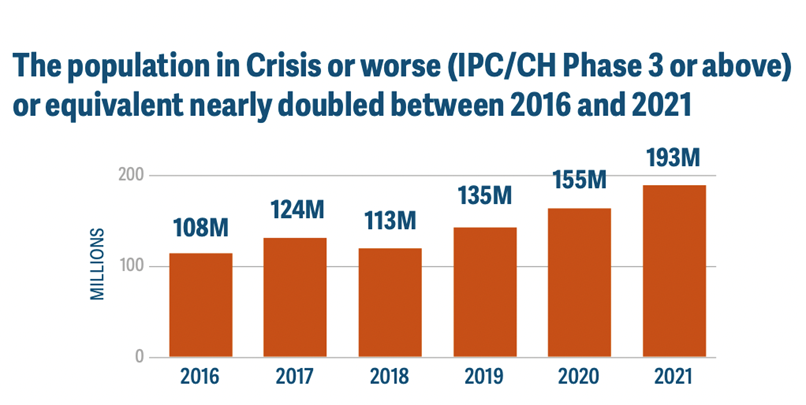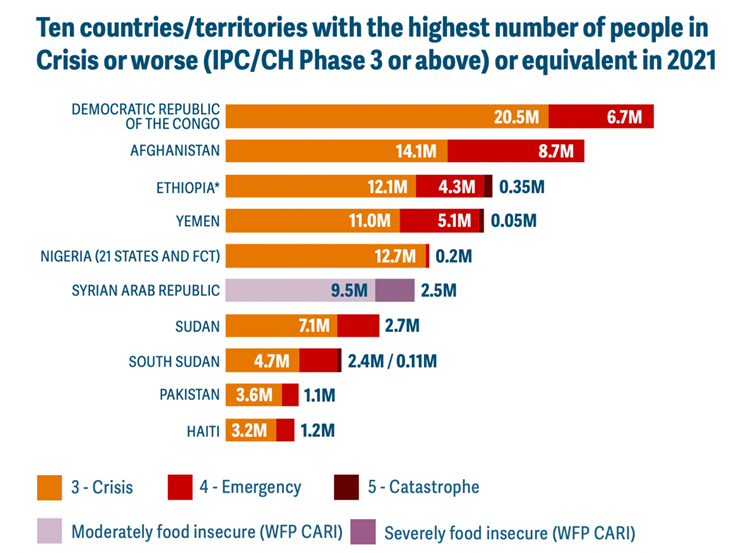In News:
- Recently, the Global Network Against Food Crises (GNAFC) published its annual report titled ‘Global Report on Food Crises’ for the year 2022.
What’s in today’s article:
- About Food Security (Definition, Components)
- Global Report on Food Crises (About GNAFC, Report Highlights, Way Ahead)
- India’s Food Security (Evolution, Challenges)
What is Food Security?
- Food security means availability, accessibility and affordability of food to all people at all times.
- Availability of food means food production within the country, food imports and the previous years’ stock stored in government granaries.
- Accessibility means food is within reach of every person.
- Affordability implies that an individual has enough money to buy sufficient, safe and nutritious food to meet one's dietary needs.
About Global Network Against Food Crises (GNAFC):
- The GNAFC was founded by the European Union, Food and Agriculture Organization (FAO), and World Food Programme (WFP) in
- It is an alliance of humanitarian and development actors working together to prevent, prepare for and respond to food crises and support the Sustainable Development Goal to End Hunger (SDG 2).
- The Global Report on Food Crises is the flagship publication of the Global Network and is facilitated by the Food Security Information Network (FSIN).
- FSIN is a global initiative co-sponsored by FAO, WFP and International Food Policy Research Institute (IFPRI) to strengthen food and nutrition security information systems for producing reliable and accurate data to guide analysis and decision-making.
- The Report is the result of a consensus-based and multi-partner analytical process involving 17 international humanitarian and development partners.
Key Highlights of Global Report on Food Crises 2022:

- Some 40 million more people globally experienced acute food insecurity at crisis or worse levels in 2021 than 2020
- The report reveals that around 193 million people in 53 countries or territories experienced acute food insecurity at crisis or worse levels in 2021.
- Of these, over half a million people (5,70,000) in Ethiopia, southern Madagascar, South Sudan and Yemen were classified in the most severe phase of acute food insecurity Catastrophe.
- These countries require urgent action to avert widespread collapse of livelihoods, starvation and death.
- An additional 236 million people were stressed across 41 countries/territories in 2021 and required livelihood support and assistance for disaster risk reduction to prevent them from slipping into worse levels of acute food security.

- In 2021, almost 70 percent of the total number of people in Crisis or worse or equivalent were found in ten food crisis countries/territories.
- The outlook for global acute food insecurity in 2022 is expected to deteriorate further relative to 2021.
Root Causes of Food Crises:
- The key drivers behind rising acute food insecurity in 2021 were:
- Conflict (main driver pushing 139 million people in 24 countries/territories into acute food insecurity);
- Weather Extremes (over 23 million people in 8 countries/territories);
- Economic Shocks - (over 30 million people in 21 countries/territories).
Suggestions:
- The international community must anticipate and act to mitigate the severe consequences of those already experiencing the highest levels of acute food insecurity.
- In contexts where food availability is limited by reduced imports, providing support to farmers to raise their productivity and improve their access to markets, and to rural communities to diversify their livelihoods and enhance their resilience to shocks is crucial.
- The urgency to do this will likely continue to grow in the coming months and years, driven by the direct and indirect effects of the war in Ukraine.
Food Security in India:
- Since the advent of the Green Revolution in the early-1970s, India has avoided famine even during adverse weather conditions.
- The availability of food grains (even in adverse weather conditions or otherwise) at the country level has further been ensured with a carefully designed food security system by the government.
- This system has two components: (a) buffer stock, and (b) public distribution system.
- Buffer Stock:
- Buffer Stock is the stock of food grains, namely wheat and rice, procured by the government through the Food Corporation of India (FCI).
- The FCI purchases wheat and rice from the farmers in states where there is surplus production.
- The farmers are paid a pre-announced price for their crops. This price is called Minimum Support Price (MSP).
- Public Distribution System:
- The food procured by the FCI is distributed through government regulated ration shops among the poorer section of the society.
- This is called the Public Distribution System (PDS).
- Ration shops are now present in most localities, villages, towns and cities.
Challenges:
- With nearly 195 million undernourished people, India shares a quarter of the global hunger burden.
- Nearly 47 million or 4 out of 10 children in India are not meeting their full human potential because of chronic undernutrition or stunting.
- The government has large-scale food security and anti-poverty programmes but there are critical gaps in terms of inclusion and exclusion errors.
- Women and girls are particularly disadvantaged.
- Despite the achievement of national food self-sufficiency, new challenges have emerged:
- Slowing agriculture growth, climate change, land degradation and shrinking bio-diversity.
- Large tracts of farmlands in India have become barren due to imbalanced fertiliser use and excessive use of a single fertiliser, urea.










